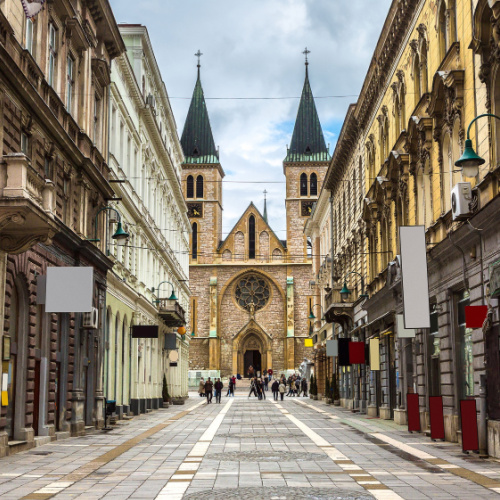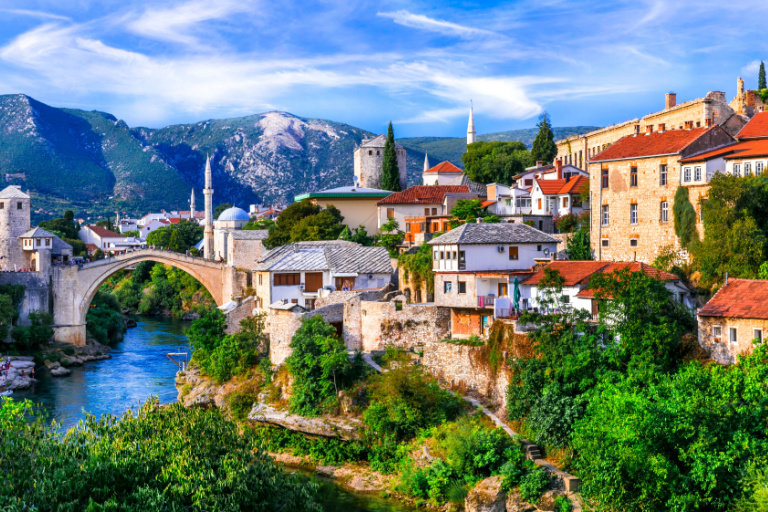
Sergii Figurnyi/Shutterstock
When Is the Best Time to Visit Bosnia?
The best time to visit Bosnia and Herzegovina is during the shoulder seasons of April-May and September-October. During these months, the weather is generally mild and sunny, with fewer crowds and lower prices than during the peak summer season of June-August.
Here are some of the benefits of visiting Bosnia and Herzegovina during the shoulder seasons:
- Mild weather: Bosnia and Herzegovina has a temperate climate, with warm summers and cold winters. The shoulder seasons offer the best of both worlds, with mild temperatures and less rain than the winter.
- Smaller crowds: The shoulder seasons are less crowded than the peak summer season, so you’ll be able to enjoy Bosnia and Herzegovina’s popular tourist attractions without having to deal with large crowds. This is especially important if you’re visiting popular destinations like Sarajevo, Mostar, and Blagaj.
- Lower prices: Prices for flights, accommodation, and activities are generally lower during the shoulder seasons than during the peak summer season. This means you can save money on your trip without having to sacrifice quality.
Here are some specific examples of how you can enjoy the most of Bosnia and Herzegovina during the shoulder seasons:
- April-May: The weather in April and May is typically sunny and warm, with occasional showers. This is a great time to visit for sightseeing in Sarajevo and Mostar, hiking in the Dinaric Alps, and attending the Sarajevo Film Festival in April.
- September-October: The weather in September and October is also typically sunny and warm, with occasional showers. This is a great time to visit for visiting the waterfalls of Bosnia and Herzegovina, attending the Mostar Diving Championship in September, and enjoying the fall foliage.
While there are many great times to visit Bosnia and Herzegovina, if you’re looking for the best weather, fewer crowds, and lower prices, then we recommend visiting during the shoulder seasons of April-May and September-October.
Additional safety note: Due to the legacy of the Bosnian War, it is important to be aware of the risks of landmines in certain areas of Bosnia and Herzegovina. Be sure to stick to marked trails and avoid areas that have not been cleared of mines.
 Average Temperatures by Month
Average Temperatures by Month
|
Jan |
Feb |
Mar |
Apr |
May |
Jun |
Jul |
Aug |
Sep |
Oct |
Nov |
Dec |
| Fahrenheit |
32°
|
36°
|
45°
|
56°
|
65°
|
72°
|
76°
|
75°
|
68°
|
57°
|
45°
|
35°
|
| Celsius |
-1°
|
2°
|
7°
|
13°
|
18°
|
22°
|
24°
|
24°
|
20°
|
14°
|
7°
|
2°
|
Climate in Bosnia
Summer Season in Bosnia
Bosnian summers are warm and sunny, especially in the lowland areas, with temperatures often ranging from 20°C to 30°C (68°F to 86°F). This season is ideal for exploring the country's natural landscapes, including its mountains, rivers, and lakes, as well as its historic cities and cultural sites. While summers are generally dry, occasional thunderstorms can occur, bringing brief periods of rainfall.
Rainy Season in Bosnia
Bosnia and Herzegovina does not have a specific rainy season, but the highest amount of rainfall typically occurs during the spring and autumn months. This precipitation is vital for the country's lush forests and agricultural lands. The rain, often in the form of sporadic showers, can bring cooler temperatures and contribute to the scenic beauty of the country's landscapes.
Winter Season in Bosnia
Winters in Bosnia and Herzegovina are cold, with temperatures frequently dropping below freezing, especially in the mountainous regions. The season is characterized by snowfall, making it a popular time for winter sports like skiing and snowboarding. In the lower areas, winters can be milder but still chilly, with occasional snow and frost. Winter transforms the country into a picturesque snowy landscape, offering a different perspective on its natural beauty.
Our Recommendations
| Destination |
Jan |
Feb |
Mar |
Apr |
May |
Jun |
Jul |
Aug |
Sep |
Oct |
Nov |
Dec |
| Bosnia |
 |
 |
 |
 |
 |
 |
 |
 |
 |
 |
 |
 |






